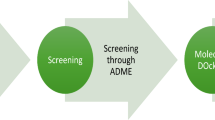Abstract
Chikungunya fever is an overwhelming, but non-fatal viral illness that has been reported in many parts of the country. The E1 domain of Q1El92_CHIKV virus that helps in binding with the host has been determined by using comparative homology modeling program MODELLER based on crystal structure of the homotrimer of fusion glycoprotein E1 from Semliki Forest virus as a template protein and it had 63% sequence identity. The modeled structure‘s energy was minimized and validated using structure validation server in which 82.8% of the residues were present in the most favored regions of the Ramachandran plot. Disulphide bonds which help in protein folding of the proteins were analyzed and it was found to be conserved for both the homologous and the modeled structures. The ion pairs which contribute to fusion of viral membranes and that help in solvent protein interactions were analyzed. Docking studies was carried out with various phytochemicals and it was found that osltamivir had the most stable interaction with the E1 domain of the Q1El92_CHIKV virus. Thus from the complex scoring and binding ability it was interpreted that Osltamivir could be a promising inhibitor for E1 domain of Q1El92_CHIKV virus as the drug target yet pharmacological studies have to confirm it.
Access this chapter
Tax calculation will be finalised at checkout
Purchases are for personal use only
Preview
Unable to display preview. Download preview PDF.
Similar content being viewed by others
References
Gubler, D.J.: Human arbovirus infections worldwide. Ann. N. Y. Acad. Sci 951, 13–24 (2001)
Ann, M.P., Aaron, C.B., Robert, B.T., Scott, C.W.: Re-emergence of chikungunya and o’nyong-nyong viruses: evidence for distinct geographical lineages and distant evolutionary relationships. J.G.V. 81, 471–479 (2000)
Khan, A.H., Morita, K., Mdel, M., Parquet, C.F., Hasebe, M.E.G., Igarashi, A.: Complete nucleotide sequence of Chikungunya virus and evidence for an internal polyadenylation site. J. Gen. Virol., 3075–3084 (2002)
Soumahoro, M.K., Gerardin, P., Boelle, P.Y., Perrau, J., Fianu, A., et al.: Impact of Chikungunya Virus Infection on Health Status and Quality of Life: A Retrospective Cohort Study. PLoS ONE 4(11) (2009)
Lokireddy, S., Vemula, S., Vadde, R.: Connective tissue metabolism in chikungunya patients. J.Virol. 5, 31 (2008)
Sali, A., Blundell, T.L.: Modeller. J.M.B. 234, 779 (1993)
Helen, M.B., John, W., Feng, Z., Gilliland, G., Bhat, T.N., Weissig, H., Ilya, N.S., Philip, B.: The Protein Data Bank. Nucl.Acids Res. 28, 235–242 (2000)
Altschul, S.F., Gish, W., Miller, W., Myers, E.W., Lipman, D.J.: Basic local alignment search tool. J.M.B. 215, 403–410 (1990)
Laskowski, R.A., MacArthur, M.W., Moss, D.S., Thornton, J.M.: PROCHECK - a program to check the stereochemical quality of protein structures. J. App. Cryst. 26, 283–291 (1993)
Author information
Authors and Affiliations
Editor information
Editors and Affiliations
Rights and permissions
Copyright information
© 2010 Springer-Verlag Berlin Heidelberg
About this paper
Cite this paper
Vasavi, C.S., Saptharshi, Radhika Devi, R., Anand, L., Varma, M.P., Krishnan Namboori, P.K. (2010). Homology Modeling and Protein Ligand Interaction to Identify Potential Inhibitor for E1 Protein of Chikungunya. In: Das, V.V., Vijaykumar, R. (eds) Information and Communication Technologies. ICT 2010. Communications in Computer and Information Science, vol 101. Springer, Berlin, Heidelberg. https://doi.org/10.1007/978-3-642-15766-0_85
Download citation
DOI: https://doi.org/10.1007/978-3-642-15766-0_85
Publisher Name: Springer, Berlin, Heidelberg
Print ISBN: 978-3-642-15765-3
Online ISBN: 978-3-642-15766-0
eBook Packages: Computer ScienceComputer Science (R0)




